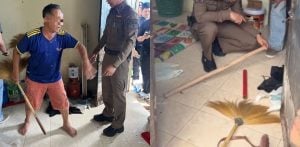Opinion: Saying it with puppets in Phuket [video]
![Opinion: Saying it with puppets in Phuket [video] | Thaiger](https://thethaiger.com/wp-content/uploads/2017/08/14_20141121151938843_uxOFqVFYxQidcNYVcyQMdvbjqFVmpiOfUPWwtkkT_jpeg.jpeg)
Rat Puanrak, 40, graduated with an electronic engineering degree from Ragamangala University of Technology in Nonthaburi. However, he made a career switch to the tourism industry before becoming a professional freelance photographer. He then began studying the art of puppetry and eventually founded the Phuket Marionette.
Here, he talks about how the art of puppetry can help children develop into well-rounded adults, as well as the importance of preserving the art for Phuket and for society as a whole.
PHUKET: When I think about puppets, I think about bringing something to life. It is a toy, but it comes alive when the puppeteer uses his or her imagination to fill it up, whether they make it walk, talk or just move around.
One of the main reasons I like puppetry is because everyone can do it. We can use this art as a way to express our thoughts and feelings to the audience, and the audience will be able to fully understand exactly what it is we are trying to convey. It allows us to connect with people.
Because I love this form of art, I want to share my experience and knowledge, including the cultural history, with children – our future. This desire led me to found Phuket Marionette.
I think that schools today focus too much on academia and do not give enough importance to art. It is essential to balance our lives. Learning the arts and how to control or channel our emotions through them helps create a well-rounded person.
Introducing puppetry to children gives them a way to express themselves, their emotions, their imaginations and their thoughts. It benefits them in the long term by sharpening their minds and teaching them how to focus and concentrate on something. It also teaches them about teamwork.
The art of puppetry is precious and has value in and of itself. Puppetry is about expressing and expanding our thoughts, along with giving joy and smiles to others. I would like to think that we, puppeteers, are a media that influences good thoughts and happiness in our audiences.
I started giving the unique art form my full attention in 2011. I was struggling to learn about and research puppetry, because most artists are quite possessive of their knowledge. Eventually, I became close with the Sema Thai Marionette Foundation in Bangkok.
At first, they were hesitant to share their knowledge, like so many others. After a while, they realized that we were on the same page – we wanted to preserve the Thai marionette. It’s a part of Thailand’s cultural identity and a part of our heritage that we should never forget.
After training, learning and researching for two years, I founded the Phuket Marionette in 2013.
In Phuket, it is the ka-lae marionette which I am trying to preserve. This art of puppetry dates back to the early days of the island, when Phuket was focused on tin mining.
The ka-lae marionette is one of Thailand’s oldest marionettes. It originated in China, and came to Phuket when the first group of Chinese migrants settled here. It was mainly performed during the mid-autumn festival, also known as the moon festival, as a ritual.
Because it is such a deeply-rooted belief that the art should be passed down only through bloodlines, there is always a chance that the ka-lae marionette could cease to exist in the future for our children and their children to see and appreciate.
Because of this, I have made a great effort to preserve this art. I was granted the rare chance to learn everything about the ka-lae, from creating the puppet to performing with it.
This art will not die with me; my goal is to preserve and pass on my knowledge to those of the next generation. More than preserving it and passing on the knowledge and traditions, Phuket Marionette has also made an effort to publicize ka-lae to everyone, not just children.
If you take the time to look into it closely, you will see how much can really be gained from the unique art of puppetry.
Latest Thailand News
Follow The Thaiger on Google News:


























